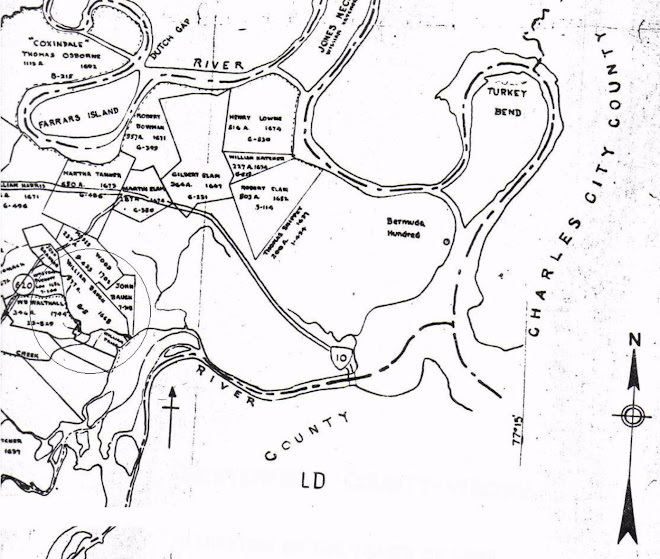Eastern part of Chesterfield County- tidewater
1622 massacre in the area include John Rolfe, former husband of Pocahontas and father of the tobacco industry
1673 plague and severe winter which killed 50,000 cattle in Virginia
Cattle were more common than horses, and hogs the most common farm animal of all. Wolves were numerous and ravaged the livestock. Negroes and Indians commonly stole hogs for food. In 1669 the Indian tribes were required by law to deliver 145 wolf heads
The settlers depended heavily on imports from England; yarn and thread and material for clothing, table linens and napkins, blankets, shoes, stockings, metal items such as razors, scissors, candlesticks, pots and pans,lanterns and lamps, fishing hooks and lines, farming implements, nails, gunpowder.
1656- Orphans and the sons of poor men were apprenticed by the parishes to be trained until the age of 21. Spinning wheels were used to make home spun cloth. William Byrd had a millstone at Falling Creek
For the wealthy, English laws of primogeniture held in England, but younger sons could be sent to Virginia to get land patents. Once established, however, primogeniture again took hold.
There were two classes; gentlemen (often planters or merchants) and servants or laborers.
1679-Richard Kennon marked himself as a merchant, Martin Elam and John Bowman called themselves planters.
Drinking was done heavily, card playing and betting a universal pastime,
Horse racing was the most popular diversion and social gathering event and breeding for sport encouraged as early as 1643. By 1663 importing horses was prohibited although export was allowed. There was a track at Bermuda Hundred. Racing disputes were common. In 1688 Abram Womack and Richard Ligon held a race with Womack's horse ridden by Thomas Cocke and Ligon's by Joseph Tanner, a servant of Thomas Chamberlaine, who was the starter. Abram Childres was the judge. Womack's horse shied from the track and Ligon's horse won the race, resulting in a dispute. Heavy betting was common at such events, and disputes went to the court.
1680- John Piggot (puckett) won 300 pounds of tobacco while playing cards with Martin Elam and claimed he was owed more
Thomas Cocke kept a tavern in 1685, but was also a planter. Hospitality at good inns and taverns were matched by the residences of wealthy landowners, who lived as if on an English estate. The landed gentry ruled the county and the state.
People traveled from one plantation to another on boats or sloops along the rivers and streams; even bridle paths were basic in those times. The settlements were limited to the rivers and creeks. The lands beyond the fall line of the James River were heavily forested and inhabited by savages.
William Farrar settled in 1656
John Puckett and John Burton settled in 1665
Abraham and William Womack (Womecke) about the same time as John Puckett
Richard Kennon settled in 1665 at Conjurer's Neck- at the junction of Swift Creek and the Appomattox river
By the 1680's land patents began gradually going westward along Swift Creek.
In 1682 William Puckett and Thomas Puckett received 750 acres in Bristol parish, north of the Appomattox river.
In 1683, Joseph Tanner and Richard Womack received a patent for 260 acres on the north side of the Appomattox river. James Baugh got a patent for 119 acres on the north of the Appomattox.
In 1690 Henry Walthall got a patent for 320 acres on the north side of swift creek in Bristol Parish. A few years later Richard Kennon, Francis Epes, Joseph Royal and George Archer got patents on the north side of the Appomatox at Winterpock Creek. In 1703 more families moved there.
Early Chesterfield county settlers
continue p. 63


